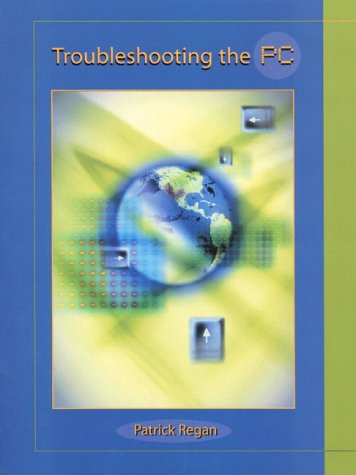Troubleshooting the Personal Computer - Softcover

"synopsis" may belong to another edition of this title.
Patrick Regan has been a PC technician and network administrator/engineer for the past 14 years. He has also taught many computer and network classes at Sacramento local colleges (Heald Colleges and MTI College), conducted considerable formal and informal training while an IT administrator (Heald Colleges) and a product support engineer for the Intel Corporation Customer service, and participated in and led many projects (Heald Colleges and Intel Corporation). For this teaching accomplishments, he received the Teacher of the Year award from Heald Colleges; in addition, he received several recognition awards from Intel. He currently works for Virtual Alert as a network engineer supporting the BioTerrorism Readiness Suite. Currently, he holds many certifications, including Microsoft’s MCSE, MCSA and MCT; COMPTIA’s A+, Network+, Server+, Linux+, Security+, and CTT+; Cisco CCNA; and Novell’s CNE.
Over the last couple of years, he has written several books including Troubleshooting the PC, Networking with Windows 2000 and 2003, Linux, Local Area Networks and WANs. Recently, Pat has started a new exciting Acing series which including Acing the A+, Acing the Network+, Acing the Security+, Acing the Server+ and Acing the Linux+.
Computers are a fast-paced technology that requires constant learning. People who learn how to fix computers must become familiar with new and old technology to become effective technicians.
This book is intended for the basic computer user who wants to be a successful PC technician and who may desire to pass the A+ Certification technician exam. For more information on the A+ Certification, see Appendix A. It is assumed that users of this book are familiar with the computer, know how to use the computer, have a general understanding of Windows, and have basic word-processing and spreadsheet skills.
Each of the chapters usually begins with basic concepts and ends with a troubleshooting section that includes questions to check understanding, emphasize troubleshooting skills, and prepare the reader to take the A+ test. Each chapter also includes hands-on exercises to reinforce basic skills and troubleshooting practices.
When planning a computer curriculum, it is often difficult for a group of computer professionals to agree on the order of topics. In this book, the basic hardware components (microprocessor, motherboard, RAM, and drives) are covered first, followed by the add-on peripherals, and ends with the operating systems. Depending on their experience, instructors may choose a different order.
As you go through the book, you will notice that a lot of information is repeated. This allows the chapters to be taught out of order and helps to complete the overall picture. In addition, I have found that the best way to teach this material is to repeat the information several times and combine it with hands-on exercises.
I have included important websites that are necessary to become a successful computer technician. Some of the hands-on exercises include finding patches, drivers, jumper settings, and technical information on the Internet.
What's New to This Edition
This edition has been updated to include the PC's newest technology and some of the chapters have been totally rewritten. With more troubleshooting coverage, this new edition is valuable to any technician. Some of the changes include:
- Chapter 5, Microprocessors, has been reorganized by architecture rather than by date and discusses Intel's Pentium 4 and other processors based on NetBurst architecture, and AMD's Athlon and Duron processors. In addition, it discusses steppings of processors and how they can affect your computer.
- Chapter 6, RAM, has also been reorganized and covers SDRAM and RDRAM. There is also a deeper discussion of troubleshooting memory problems including the BIOS setup options.
- Chapter 7, Motherboards, has been supplemented with extensive coverage of motherboard form factors, and many BIOS setup program options have been added. In addition, material has been added to the troubleshooting section of motherboards, including how the BIOS affects reliability.
- Chapter 8, The Expansion Slots and Cards, includes USB and IEEE 1394 and discusses common problems that you might encounter when installing devices using these buses.
- Chapter 9, The Case and Power Supply, discusses the various form factors with power supplies and computer cases. It also introduces the ATX12V power supply.
- Chapter 10, The Hard Drive, provides an updated section on EIDE drives, which include the Ultra-DMA hard drives and serial ATA hard drives, and more information on the various types of SCSI drivers. The chapter also discusses the Intel Ultra ATA storage driver.
- Chapter 22, Windows 9X, has been expanded to include Windows 95, Windows 98, and Windows Millennium. It also discusses the troubleshooting tools, including the system information utility and the system configuration utility; discusses common problems encountered, including what to do when Windows 9X does not shut down properly; general protection/exception errors; and performance monitoring of Windows 9X.
- Chapter 23, Windows NT Family, has been rewritten and includes expanded coverage of Windows NT, Windows 2000, and Windows XP Many of the troubleshooting tools available in Windows, including the ERD and Recovery Console, are explained, and stop errors and performance monitoring are discussed in detail.
- Chapter 24, Computers Connected to a Network, has been expanded to reflect the new A+ Certification exam and discusses a wide range of topics.
"About this title" may belong to another edition of this title.
- PublisherPearson College Div
- Publication date2000
- ISBN 10 0130957968
- ISBN 13 9780130957962
- BindingPaperback
- Number of pages655
Buy New
Learn more about this copy
Shipping:
US$ 3.99
Within U.S.A.
Top Search Results from the AbeBooks Marketplace
Troubleshooting the Personal Computer
Book Description Paperback. Condition: New. PAP. Seller Inventory # 53M000000OUO

